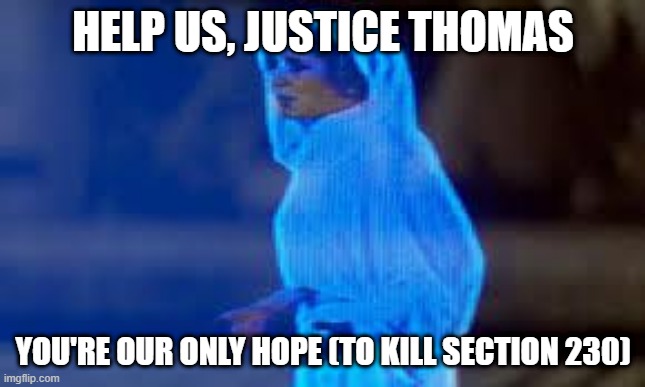Justice Thomas once more expresses outrage over Segment 230. – Doe v. Snapp

I described this example previous:
A highschool trainer allegedly used Snapchat to groom a sophomore pupil for a sexual courting. (Typically, the trainer was once feminine and the sufferer was once male, however on this incident gender is beside the point).
The trainer was once sentenced to 10 years in jail, so the prison device has already held the culprit responsible. Nonetheless, the plaintiffs have pursued further defendants, together with the college district (that go well with failed) and SNAP.
We must be actual about Snap’s function on this tragedy. The trainer and pupil exchanged non-public messages on Snap. Snap most often does no longer have the prison proper to learn or observe the contents of the ones messages. Thus, any case in keeping with the message content material falls squarely inside of Snap’s purview to grasp the ones contents. To keep away from this, the plaintiffs mentioned Snap must have discovered a option to save you the trainer and pupil from connecting on Snap. However those customers already knew every different offline; this isn’t like a stranger-to-stranger connection. Moreover, Snap may just most effective save you those folks from connecting on its community if it engaged in invasive consumer authentication, corresponding to age authentication (to split minors from adults). Then again, the First Modification has held for many years that services and products can’t be legally pressured to accomplish age authentication on-line. The plaintiffs additionally claimed that Snapchat’s “ephemeral” messaging capability is a unsuitable design, however the Charter does no longer permit legislatures to pressure messaging services and products to retain non-public messages indefinitely. In reality, Snapchat’s ephemerality raises socially vital privateness issues. In different phrases, this example does no longer prevail regardless of how it’s framed: both it’s in keeping with the content material of the messages, which Snap can’t learn, or it’s in keeping with the web site’s design alternatives, which don’t seem to be matter to check because of the Charter.

The District Court docket pushed aside the case as in keeping with Segment 230. On enchantment, a three choose panel of the 5th Circuit affirmed in a temporary in keeping with curiam opinion that necessarily inspired the plaintiffs to call for an en banc listening to. The plaintiffs’ en banc request was once denied, however with some drama. The vote for an en banc listening to was once 7 sure and eight no, and the 7 sure votes wrote a dissent full of misstatements about, and hatred of, Segment 230. That shut vote places all long run appeals of Segment 230 within the 5th Circuit in a blender. Moreover, the dissent known as out Justice Thomas many times with the hope that it would convince him to take the case. I summarized the entire theme of the dissent with this meme:
The plaintiffs appealed the case to the Perfect Court docket, and the day prior to this the Perfect Court docket denied certiorari – and upheld the 3-judge panel’s transient in keeping with curiam affirmance.
Then again, the 5th Circuit’s Leia sign reached Justice Thomas. He wrote a brief dissent to disclaim certiorari, which was once additionally joined by way of Justice Gorsuch. This isn’t the primary time Justice Thomas has offered non-precedential critiques criticizing Segment 230 (see hyperlinks under). Despite the fact that the dissenting opinion is legally beside the point and redundant together with his earlier writings towards Segment 230, I as soon as once more fact-check Justice Thomas’s remedy of Segment 230. As I’ve mentioned in the past, I take no excitement in examining phrases at this stage of element, however it will be important to focus on Justice Thomas’ rhetorical strikes that solid undesirable shadows on Segment 230 and its applicability right here.
,
Thomas provides: “The Court docket has no longer thought to be whether or not social media platforms — probably the most greatest and maximum robust corporations on the planet — will also be held answerable for their very own misconduct.”
Eric replies: Incorrect. Through its phrases, Segment 230 does no longer observe to defendants’ personal content material or habits – despite the fact that the Perfect Court docket by no means addresses the problem. Plaintiffs can at all times selfishly declare that their claims goal first-party content material/habits, however that doesn’t imply this characterization is right. On this case, the best way the plaintiffs offered the case was once obviously unreliable.
“A social media platform isn’t legally accountable as a writer or speaker for the content material of its customers,” Thomas says.
Eric replies: True! This can be a restatement of Segment 230. This sentence explains why the plaintiff misplaced this example.
Thomas provides: “The query of whether or not Segment 230 immunizes platforms for their very own habits merits the Court docket’s evaluation.”
Eric replies: Odd. This can be a query the Perfect Court docket does not want to resolution. The regulation itself solutions this query. Segment 230 does no longer immunize services and products “for their very own habits.”
Thomas says: [In Gonzalez v. Google, the justices] “Then again, we had been not able to achieve the scope of Segment 230, as plaintiffs’ claims would have failed at the deserves.”
Eric spoke back: True. The 230 factor was once mentioned and debated within the Gonzalez case. Everybody sought after the Perfect Court docket to factor an opinion discussing Segment 230. You had your likelihood.
“Social media platforms have used Segment 230 as a get-out-of-jail-free method,” Thomas says.
Eric replies: Incorrect in two tactics. First, the services and products don’t seem to be the usage of Segment 230 “more and more.” They have got used it constantly since day one. 2nd, Segment 230 explicitly excludes federal felony prosecutions and at all times has. This put up explains why the “get out of reformatory loose card” analogy for Segment 230 is flawed and must by no means be used.
“Many platforms declare that customers’ content material is their very own First Modification speech,” Thomas says.
Eric responds: Severely? That is clearly false. The Services and products declare First Modification coverage for his or her movements as publishers of third-party speech, together with collecting, organizing, and disseminating that content material. The Services and products don’t declare that the third-party content material is their very own speech.
“As a result of platforms arrange customers’ content material into newsfeeds or different compilations, the argument is going, platforms interact in constitutionally secure speech,” Thomas says.
Eric spoke back: That “argument” was once supported by way of 5 Perfect Court docket Justices within the Moody opinion on Monday. Smartly-sounding critique of his colleagues.
“The platforms declare that as a result of they aren’t audio system underneath Segment 230, they can’t be sued for customers’ content material, despite the fact that the go well with revolves round alleged misconduct by way of the platform,” Thomas says.
Eric replies: Incorrect in two tactics. First, as mentioned above, defendants don’t and can’t use Segment 230 for their very own “misconduct.” They may be able to most effective declare Segment 230 immunity for claims in keeping with third-party content material. 2nd, “platforms” don’t seem to be merely “claiming” that “they aren’t audio system.” As a substitute, that is what Congress explicitly declared in Segment 230. The statute states that services and products might not be handled as publishers or audio system of third-party content material. This can be a statutory truth created by way of Congress that services and products don’t seem to be audio system of third-party content material. It’s actually within the statute.
Thomas says: “Within the platform international, they’re totally accountable for their web pages when that provides them constitutional coverage, however the second that accountability may just result in legal responsibility, they may be able to deny any legal responsibility and experience extra coverage from proceedings than nearly every other business.”
Eric replies: This isn’t simply the “international of platforms.” That is the regulation of america. Justice Thomas once more explains how Congress added Segment 230 to the constitutional protections within the First Modification. As I give an explanation for right here, Segment 230 is a speech-enhancing statute that dietary supplements the baseline writer protections ensured by way of the First Modification. That paper additionally explains how the supplemental protection equipped by way of Segment 230 has many advisable coverage implications past the Charter.
Case citations: Doe v. Snap, Inc., 2024 WL 3259814 (US Perfect Court docket July 2, 2024).
Prior put up on Justice Thomas’ non-precedential statements towards Segment 230 (Word: I counsel you don’t re-read those posts, as Justice Thomas’s unbiased critiques at the regulation are painful to learn):
Supply hyperlink
#Justice #Thomas #expresses #outrage #Segment #Doe #Snapp



